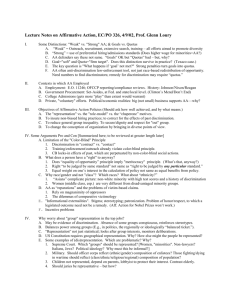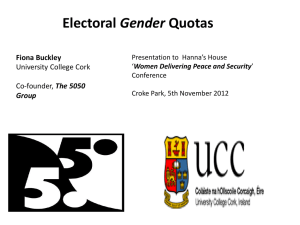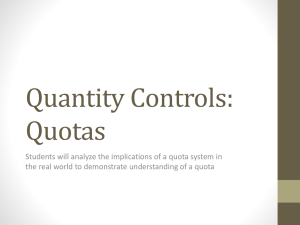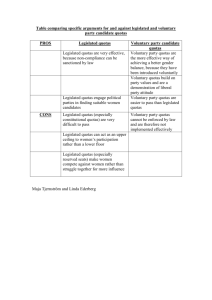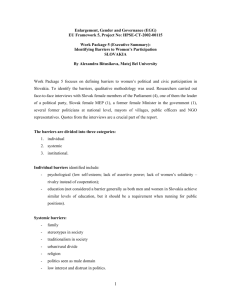Comparative Studies of Electoral Gender Quotas
advertisement
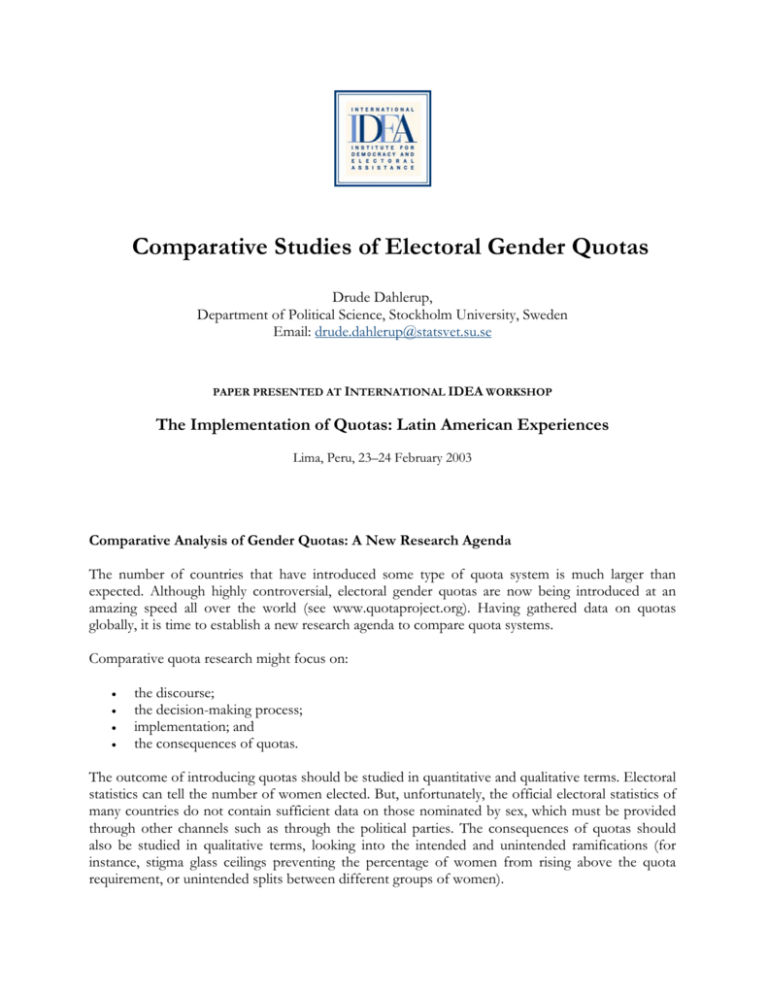
Comparative Studies of Electoral Gender Quotas Drude Dahlerup, Department of Political Science, Stockholm University, Sweden Email: drude.dahlerup@statsvet.su.se PAPER PRESENTED AT INTERNATIONAL IDEA WORKSHOP The Implementation of Quotas: Latin American Experiences Lima, Peru, 23–24 February 2003 Comparative Analysis of Gender Quotas: A New Research Agenda The number of countries that have introduced some type of quota system is much larger than expected. Although highly controversial, electoral gender quotas are now being introduced at an amazing speed all over the world (see www.quotaproject.org). Having gathered data on quotas globally, it is time to establish a new research agenda to compare quota systems. Comparative quota research might focus on: • • • • the discourse; the decision-making process; implementation; and the consequences of quotas. The outcome of introducing quotas should be studied in quantitative and qualitative terms. Electoral statistics can tell the number of women elected. But, unfortunately, the official electoral statistics of many countries do not contain sufficient data on those nominated by sex, which must be provided through other channels such as through the political parties. The consequences of quotas should also be studied in qualitative terms, looking into the intended and unintended ramifications (for instance, stigma glass ceilings preventing the percentage of women from rising above the quota requirement, or unintended splits between different groups of women). What happens when electoral gender quotas are introduced in political systems as dissimilar as those of Argentina, France, India, Pakistan, South Africa, Sweden and Uganda? What are the theoretical and methodological problems implied in comparing the introduction of electoral quotas in extremely different political systems around the globe? My research interest is in the relation between the discursive controversies surrounding the introduction of quotas, the actual implementation or non-implementation of quota systems and the outcome. Under what conditions do quotas contribute to the empowerment of women? When do gender quotas lead to unintended negative effects like stigmatization and marginalization? With some outstanding exceptions, research on quotas has, until now, primarily been limited to one country, or to the employment of quotas in different electoral systems. It is, however, relevant to widen the perspective, and to discuss how to conduct research that compares quota discourse and implementation processes and results under different electoral systems, different political cultures and different gender regimes. Existing one-country studies seem to come up with quite different conclusion about the ability of quota systems to empower women. Yet, those differences might derive from the chosen approach rather than from actual differences between countries. The introduction of quotas is increasingly influenced by recommendations from international organizations and by cross-country inspiration. However, the new international idea of quotas, or ‘quota fever’, as it is now called in Southeast Asia, confronts very different contexts. Today, electoral gender quotas are being introduced in countries where women have been almost entirely excluded from politics, as well as in countries with a long history of mobilization of women into the labour market and into political life—such as in the Scandinavian countries, where electoral quotas were not introduced until the 1980s, when women’s parliamentary representation already exceeded 25 percent. The introduction of effective quota systems represents a change in public equality policy, from ‘equal opportunities’ to ‘equality of results’. Quota systems thus represent a break with the widespread gradualism in equality policies. Seen in this perspective, the history of the Scandinavian countries can no longer be considered a model for obtaining equal political representation around the globe. Why Scandinavian is No Longer the Model For many years feminist organizations throughout the world have viewed the Scandinavian countries, Denmark, Finland, Norway and Sweden, as a model for women’s equality. One key factor has been the very high representation that women have enjoyed in parliaments and local councils in these countries, especially since the 1970s. Table 1: Percentage of Women in Scandinavian Parliaments in 2003 Country Sweden Denmark Finland Norway Iceland Women in Parliament 45% 38% 37% 36% 35% Election Year 2002 2001 1999 2001 1999 This extraordinarily high level of representation, seen in a global perspective, has led to the question: how did you come that far? What can we learn from the Scandinavian experience? As Nordic researchers we have tried to answer these questions by pointing to structural changes in these countries, such as secularization, the strength of social-democratic parties and the development of an extended welfare state, women’s entrance into the labour market in large numbers in the 1960s, the educational boom of the 1960s, and the electoral system. Strategic factors are also seen as important, especially the various strategies employed by women’s organizations in the Nordic states in order to raise women’s political representation. I will, however, argue that the Scandinavian experience cannot be considered a model today, because it took 80 years to get that far. Today, the women of the world are not willing to wait that long. The introduction of electoral quotas is a symbol of their impatience, as well as an often efficient tool for increasing female representation. A very good example is South Africa, where the introduction of quotas by the African National Congress (ANC) resulted in female representation in this new democracy jumping to an international high of about 30 percent.1 Different Quota Systems Even if constitutional amendments and new electoral laws may seem more commanding, it is not at all evident that they are more efficient when it comes to implementation than party quotas. It all depends on the actual rules and the possible sanctions for non-compliance, and on the general opportunity structure of the country for quotas. A distinction must be made between quotas for: (a) the pool of potential candidates; (b) the actual nominees; and (c) the elected. There are examples of quota requirements on all three levels, but most quota systems relate to (b). Here, the crucial question relates to where, for instance, the required 40 percent of women are placed on the lists or in the districts with real chances of election. The partly unsuccessful ‘women’s short lists’ in England provide an example of the employment of quotas on the first level, which broadens the pool from which the selection committee or the primary may chose. ‘Reserved seats for women’ is a different quota system, in which certain seats are set aside, as in Uganda, for instance, where certain regional seats are reserved for women. The electoral quota for women may be constitutional (as in Nepal, the Philippines and Uganda), legislative (as in many parts of Latin America and, for example, in Belgium, Bosnia–Herzegovina, Serbia and Sudan) or it may take the form of a political party quota. In some countries, numerous political parties apply some type of quotas, such as in Argentina, Bolivia, Ecuador, Germany, Italy, Norway and Sweden. But in many other countries only one or two parties have opted to use quotas. If the leading party in a country uses quotas, however, like the ANC in South Africa, this may have a substantial effect on the overall representation of women. Yet, most political parties around the world do not employ any kind of quota system at all. Gender quotas may apply to the number of female candidates proposed by a party for election, or they may take the form of reserved seats in the legislature. In some countries, quotas apply to minorities based on regional, ethnic, linguistic or religious cleavages. Almost all political systems apply some kind of geographical quota to ensure a minimum representation for densely populated areas, islands and the like. That type of quota is usually not considered as controversial as gender quotas. Quotas work differently under different electoral systems. Quotas are most easily introduced in proportional representation (PR) systems and other multi-list systems. Also several majority systems have introduced quota provisions, as the Electoral Quotas for Women website shows. But even in a PR system, because of the few candidates elected, small parties and parties in small constituencies have difficulties implementing quotas without controversial central interference in the usual prerogatives of the local party organization to select their own candidates. Gender-Neutral Quota Provisions? Most quotas aim to increase women’s representation, since the problem to be addressed usually is the under-representation of women; this is particularly relevant since women usually constitute 50 percent of the population. An electoral gender quota regulation may, for example, require that at least 40 percent of the candidates on the electoral lists are women. A minimum requirement for women implies a maximum set for the representation of men. Since women are the underrepresented group in political institutions, most regulations seek to secure for women a greater minimum number of seats than before. Some quota systems, though, are constructed as gender-neutral, which means that they aim to correct the under-representation of both women and men or at any rate establish a maximum for both sexes. In this case, the requirement may be that neither gender should occupy more than 60 percent and no less that 40 percent of the seats. A 50:50 quota is in its nature gender-neutral, and it also sets a maximum in terms of the representation of women, which a minimum requirement for women does not do. The concept of a ‘double quota’ is used to refer to a quota system that not only requires a certain percentage of women on the electoral list, but also prevents women candidates from merely being placed at the bottom of the list with very little chance of being elected. Argentina and Belgium are examples of countries with legal double quota requirements. Quota Controversies Quotas are very controversial, yet several countries around the world, including such diverse ones as Argentina, Bosnia, France, South Africa, Sweden and Uganda, have recently introduced gender quotas in public elections. An electoral gender quota system sets up a quantitative prescription for the minimum representation of either sex, such as 40 percent. Sweden’s ‘every second a women’ and ‘parité’ (France, Belgium) are other names for quota systems. In political life, quotas have often engendered vehement debate. Research on quotas so far has tended to concentrate on these debates and on the actual decision-making process. These discursive controversies are also an essential part of the present research project, but, in addition, an emphasis is being placed on the too often neglected aspect of the troublesome implementation of quotas and on the consequences of introducing quotas. From studies of single countries, we know that a decision to introduce a requirement of a minimum of, for instance, 30 percent of each gender on the electoral lists does not automatically lead to women getting 30 percent of the seats. Thus, by comparing the use of quotas in many similar and different political systems, it is possible to illuminate whether and under what conditions quotas can be considered an equal policy measure that contributes to the stated goal: equal political citizenship of women. Introducing quotas is always highly controversial, yet the debates are often confused and only understandable if the hidden assumptions about women and women’s position are scrutinized. This makes it possible to see why quotas for some are seen as discrimination and a violation of the principle of fairness, while others consider them to be compensation for the structural barriers that prevent fair competition. The idea of quotas is frequently in conflict with other notions like the prevailing discourse of fairness and competence, and the idea of individualism. However, quotas are seen as an efficient measure to attain ‘real’ equality, that is, equality of results. An unclear debate and lack of legitimacy of the claim often lead to problems at the stage of implementation. In an earlier survey of quotas among the political parties in the Nordic countries and women’s organizations in the same parties, the Norwegian Labour Party declared that it took three elections to implement a quota system. Why? Because the party does not throw out a male incumbent member of parliament (MP) in order to include a women. The results of previous single-country studies are quite diverse. They range from the partial failure of the attempt to introduce women’s short lists in a majority electoral system like that of England, which nevertheless showed some positive results,2 through often ‘minimalistic’ compliance with the rules by the political parties, which has resulted in small and uneven gains in female representation in Latin America,3 to the somewhat negative consequences of reserved seats for women in Uganda as they become stigmatized.4 Research on Women in Politics Today, we see a worldwide increase in the political representation of women, but the regional differences are immense (the world average is 15 percent in 2003 according to the IPU). The international research community has taken a strong interest in the results of Nordic research, because, since the 1970s, female representation there has been extraordinary high by international standards. This has sometimes been attributed to the introduction of quotas.5 However, this view is not accurate, since quotas in the Nordic countries were introduced after women’s representation had taken off in the 1970s, and not all Nordic political parties use quotas—those that do are mostly the parties in the centre and on the left. Furthermore, the few Danish parties with quotas abolished the system after just a few years. The Swedish principle of ‘every second a women’ is not even considered a quota system by the general public, even if it is in fact a radical one, demanding and, in many cases, leading to 50 percent of each sex. We need more international comparative studies of quota systems and of women in politics in general.6 The many empirical single-country studies and examinations of women in politics carried out over the past two decades7 have paved the way for new, cross-national comparison research projects. Research on gender and politics has tried to answer the two most frequently asked, yet rather complicated, questions: first, how did this increase in women’s representation come about?8 And, second, what difference does having many women in politics make?9 The interaction between the elected women and women’s organizations has been seen as important to the performance of female politicians and vice versa.10 One conclusion is especially relevant for the introduction of quotas. In almost all political systems, no matter what the electoral regime, it is the political parties, not the voters, which are the real gatekeepers in regard to elected offices. Consequently, party nomination practices should be kept in focus.11 A new trend is also the growing interest in theoretical questions within gender studies, including the study of gender and politics. The concept of citizenship has been central to many feminist research projects in recent years, focusing on welfare state development and on the historical connection between political, social and civic citizenship.12 The concept of citizenship guides our attention to comparisons between the political exclusion and inclusion of women and that of other groupings or categories. The new philosophical discussion of women as a contested category is also highly relevant for studies of gender and politics, and will be examined later. The Stockholm University Research Project: ‘Quotas—Key to Equality?’ There is a clear consensus among comparative studies of female representation in parliament that quotas have a positive impact on the numbers of women represented. To date, there has been no evaluation of the extent to which the form and efficacy of gender quotas are determined by the model of citizenship and political system operating within particular countries. This project addresses this absence. It seeks to establish whether the precise form and perceived efficacy of quotas depend on the nature of citizenship at the discursive level, and the nature of the political system at the institutional level. The use of quotas is increasingly influenced by international recommendations and by cross-country inspiration. The international idea of quotas, however, confronts very different contexts in individual countries. This phenomenon is at the core of the project. Consequently, quotas are being introduced in countries that do not have a long history of mobilization of women and of women’s integration into the labour market and political life, as was the case in the Nordic countries.13 There is not one but several models concerning the empowerment of women, usually defined as the ability to act and to prevent action, while citizenship refers to rights and capacities for collective action. The Theoretical Discussion In the discussion of quotas, several important discussions about principles merge. Quotas represent a change in public equality policy, from ‘equal opportunities’ to ‘equality of results’. But quotas also touch on fundamental questions in democratic and feminist theory, and this project intends to contribute to these theoretical discussions.14 In her classic text, The Concept of Representation, Hanna Pitkin argues that there is no common understanding about the nature of representation and about what fair representation is.15 In regard to the distinction between the representation of ideas and social representation,16 quotas for women relate to the latter position. Opponents of quota systems often argue from the standpoint of the former. The concepts of universal versus differentiated citizenship are under discussion here. Also at play are different concepts regarding the role of the politician: the delegate with a closed mandate versus the true representative or the public servant versus the group representative.17 Anne Phillips advocates gender quotas in a system that combines the politics of ideas with the politics of presence. Even if she sees the many arguments against quotas, Phillips asks why everybody agrees on the demand for the equal participation of women, but not for equal representation. The fact that women all over the world have been excluded must be taken as the starting point, not the abstract principles of representation.18 Even if quotas are often met with suspicion, all electoral systems include some kind of quotas, for instance, geographically-based quotas, where more densely populated areas are given a disproportionate number of seats in parliament. The relation between gender quotas and quotas for other social groupings is complicated, since there are women in all (other) social groups. Quotas touch on the discussion of why female representation is important. Three arguments can be found today as well as in the campaigns for suffrage: • • • women represent half of the population and hence have the right to half of the seats (the justice argument); women have different experiences (biological or socially constructed) that ought to be represented (the experience argument); and women and men have partly conflicting interests and thus men cannot represent women (the interest group argument).19 A fourth argument deals with the importance of women politicians as role models, who may pave the way for other women to enter politics. In Gender and Citizenship, Birte Siim distinguishes between three models of citizenship: the liberal (UK, USA), the participatory (Scandinavia), and the republican (France). The introduction of quotas by Belgium and France under the name of ‘parité’ is supposed to transcend the controversial concept of group representation. Based on and developing a republican understanding of citizenship, parité ‘does not mean simply adding women but implies the recasting of the social pact which enables women to be representatives of the universal, which makes ample room for the recognition of a plurality that is irreducible to the plurality of opinions and therefore makes room for the introduction of otherness in representation’.20 Quotas also touch on the present philosophical dilemma within feminist theory concerning ‘the category women’ and point to the old problem, so well known by the feminist movement, that not all women identify with the group ‘women’. Women as a group are both the Achilles’ heal of the feminist movement and its raison d’être. ‘The proletariat say “We”, Negroes also. Regarding themselves as subjects, they transform the bourgeois, the whites, into “others”. But women do not say “We” … Men say “women”, and women use the same word in referring to themselves’.21 The present critique within feminist theory is partly a critique of Western ethnocentrism, stressing the principle of multiple identities, and partly a poststructuralist critique, that feminism tends to construct the very category it wants to dissolve.22 But instead of labelling with static concepts of ‘essentialism’, the dilemmas facing, and the strategic choices of, women in various contexts should be explored empirically.23 Studying quota systems implies analysing what concepts of representation and which understanding of ‘women’ as a group are at play in global discussions of quotas for women. A comparative research design allows for analysis of how quotas are introduced and how they work in different contexts (structures as well as actors). A selected number of countries from all regions of the world will be included, the choice of which will based on the expertise of the international research network created for this project. It will be necessary to supplement previous single-country studies with comparative studies in order to fill gaps. The project will result in articles for scientific journals and a larger book on quotas, which will include single-country studies by internationally reputed scholars, in addition to chapters dealing with the comparative aspects. Furthermore, a handbook for a general audience is planned in co-operation with the International Institute for Democracy and Electoral Assistance (IDEA). The international project will deal with the following four aspects of quotas as a policy measure. The Discourse The project will study the debate on quotas, which seems to be particular to each country, as it is connected to other recent debates and to the general discourse on the meaning of gender and democratic representation (see above). Even if discourses are increasingly international, the actual debates still take place predominantly within national or regional linguistic boundaries. Thus, Mala Htun and Mark P. Jones argue that the principles of gender equality in Latin America have been gradually incorporated into the prevailing understanding of democracy and modernity, which gives quotas a symbolic value. Notions of difference versus sameness are at play in these debates: whether quotas are seen as a temporary or permanent measure can be used as a test of the ontological understanding of gender differences.24 Furthermore, if quotas are the answer, what then is the understanding of the problem and how is it constructed in the public debate?25 The Decision-Making Process The project will compare the decision-making process in the selected countries. Here the institutional setting, the party structure and the influence of the women’s movement become crucial. Who were the main actors behind the introduction of quotas? Some countries have introduced quotas by amending their constitution or by the passing of legislation. In these cases, the state intervenes in order to secure equal representation. In the Nordic countries, gender quotas have only been defined in law in the case of appointed representation on public committees and boards.26 In public elections in the Nordic countries, quotas are based exclusively on the political parties’ own decisions, as in the case of the Swedish ‘zipper-system’. Consequently, it is easy to remove quotas again, as the Danish case reveals. The Implementation of Different Kinds of Quotas The project will scrutinize the implementation process, a usually neglected aspect of quotas—by researchers as well as by policy-makers. This study deals only with quotas that are applied in processes of selection potential or actual candidates for public elections. The issue of internal party quotas is thus omitted, as are quotas for public commissions and boards. National elections are highlighted, but regional and local public elections are only included providing the data is available. This comparative study can contribute to a much more solid understanding of how different types of quotas work, seen in relation to different electoral and nomination systems (for instance, primaries or not, the degree of centralization of the party organizations, and closed versus open lists). It is a preliminary finding that quotas are less likely to be applied and to succeed in electoral systems based on single-member constituencies, where each party only presents one candidate— contrary to proportional representation systems. But even in a PR system, small parties and parties in small constituencies have difficulties implementing quotas without controversial central interference in the usual prerogatives of the local party organization to select their own candidates.27 Thus conflicts with other principles might hinder implementation. The legitimacy of the quota system is crucial. It is one of the hypotheses of this project that the character of the debate leading to the introduction of quotas is just as important to the result as the electoral system. Consequences of Quotas The result of introducing quotas will be studied in quantitative as well as in qualitative terms. Electoral statistics can tell the number of women elected. Unfortunately, the official electoral statistics in many countries do not have sufficient data on those nominated by sex, which must be provided through other channels, for example, through the parties. The consequences of quotas should also be studied in qualitative terms, looking into the intended as well as the unintended consequences (e.g. stigmatization, glass ceilings preventing the percentage of women from rising above the quota requirement — or unintended splits between different groups of women). The preliminary hypothesis of this project is that quotas that rest on a previous mobilization and integration of women into all parts of society have a better chance of success than those without this precondition, that is, to lead to the permanent empowerment of women and equal political citizenship. Since quotas in themselves do not remove all of the other barriers to full female citizenship, the crucial question is whether quotas imposed as a result of international inspiration without mobilization among larger groups of women can achieve the goal. Does a critical mass of women count in itself?28 The interplay between the national and the international level will also be subject to analysis, especially the influence of the many international bodies, which increasingly issue recommendations, and even rules, in the field of equality policy. Quotas have been recommended by the United Nations (UN), the Inter-Parliamentary Union (IPU), the European Union (EU) and the Organization for Security and Co-operation in Europe (OSCE)—for example, in the United Nations Convention on the Elimination of All Forms of Discrimination against Women (CEDAW) and the Beijing Platform for Action, both 1995. Many international organizations have worked on this question; IDEA, the OSCE, the IPU and the EU all have projects on women and decisionmaking. No doubt, these international recommendations have given legitimacy to the use of quotas. A special study of the activities of the international community pertaining to the introduction of gender quotas in Bosnia–Herzegovina is part of this project. To what extent and under which circumstances has it been possible for actors like the women’s movement to use the international recommendations and cross-national co-operation between organizations to promote their case at home. The theoretical framework for this study is the present discussion as to whether social movements, in general, get more opportunities as a consequence of the processes of internationalization and globalization or whether they are, in fact, disempowered by these developments, unless they transform from being democratic grassroots movements and become professional non-governmental organizations (NGOs).29 Notes Ballington 1998, 2000. Squires 1996. 3 Htun and Jones 2002. 4 Christensen 1999. 5 Phillips 1995. 6 Rule 1987; Karam 1998. 7 Dahlerup 1986, 1988–90; Lovenduski & Norris 1993,1998; Nelson & Chowdhury 1994; Jalusic & Antic 2001. 8 Bergqvist 1999; Haavio-Mannila, Eduards, Dahlerup et al., 1985; Karvonen & Selle 1995; Lovenduski 1986; Sainsbury 1993. 1 2 Skjeie 1992; Walby 1999; Wängerud 1998. Dahlerup 1998a; Gustafsson 1997. 11 Dahlerup 1998b; Lovenduski & Norris 1996. 12 Lister 1997; Sainsbury 1999; Siim 2000. 13 Bergqvist 1999. 14 Fraser 1997; Phillips 1995; Young 1990. 15 Pitkin 1967. 16 Esaiasson & Holmberg 1996; Phillips 1995. 17 Squires 1996. 18 Phillips 1995. 19 Dahlerup 1978; Phillips 1995. 20 Marques-Pereira 2000, p. 23. 21 Beauvoir 1949. 22 Benhabib et al. 1995. 23 Dahlerup 2001. 24 Dahlerup 2001. 25 Bacchi 1999. 26 Dahlerup 1988–90; Bergqvist 1994. 27 Matland 1998; Dahlerup 1988–90. 28 Dahlerup 1988. 29 Dahlerup 2000b. 9 10 References Bacchi, Carol Lee. 1996. Politics of Affirmative Actions. Women, Equality and Category Politics. London: Sage. Bacchi, Carol Lee. 1999. Women, Politics and Policy. London: Sage. Ballington, Julie. 1998. “Women's Parliamentary Representation. The Effects of List PR”. South African Journal of Political Studies, 25/2, pp. 77–93. Ballington, Julie. 2000. “Representation of Women in Political Parties”. South African Local Government Elections 2000. Electoral Institute of Southern Africa (EISA), No. 6. Bergqvist, Christina et al., eds. 1999. Equal Democracies? Gender and Politics in the Nordic Countries. Oslo: Scandinavian University Press. Benhabib, Seyla et al. 1995. Feminist Contentions. New York & London: Routledge. Caul, Miki, 1999. “Women’s Representation in Parliament”. Party Politics, Vol. 5/1, pp. 79–98. Christensen, Trine Grønborg. 1999. “A Woman’s Place is in the House—State House!” Speciale, Department of Political Science, University of Aarhus. Dahlerup, Drude. 1978. “Women’s Entry into Politics. The Experience of the Danish Local and General Elections 1908–20”. Scandinavian Political Studies, Vol. 1, nos. 2–3, pp. 139–162. Dahlerup, Drude. 1986. The New Women's Movement. Feminism and Political Power in Europe and the U.S.A. London: Sage. Dahlerup, Drude. 1988–90. Vi har ventet længe nok (We have waited too long). In Danish (1988), Icelandic (1988), Norwegian (1989), Swedish (1989) and in Finnish (1990). Dahlerup, Drude. 1988. “From a Small to a Large Minority: Women in Scandinavian Politics”. Scandinavian Political Studies, Vol. 11, No. 4, pp. 275–298. Dahlerup, Drude. 1998a. Rødstrømperne. Den danske Rødstrømpebevægelses udvikling, nytænkning og gennemslag 1970–85, Vol. 1–2. Copenhagen: Gyldendal. Dahlerup, Drude. 1998b. “Using quotas to increase women’s political representation”. In Karam, Azza, ed. Women in Politics: Beyond Numbers. Stockholm: IDEA. Available on the internet at http://www.int-idea.se/women/. Dahlerup, Drude. 2001. “Ambivalenser och strategiska val. Om problem i kvinnorörelsen och i feministisk teori kring särart och jämlikhetsbegreppen”. Kvinnovetenskaplig Tidskrift, No. 1, pp. 17–40. Esaiasson, Peter and Søren Holmberg. 1996. Representation from Above – Members of Parliament and Representative Democracy in Sweden. Aldershot: Dartmouth Publishing. Freidenvall, Lenita. 1999. Betydelsen av kön i kommunalpolitiken ur ett generationsperspektiv. MA thesis, Department of Political Science, Stockholm University. Fraser, Nancy. 1997. Justice Interruptus. Critical Reflections on the ‘Postsocialist’ Condition. New York & London: Routledge. Gustavsson, Gunnel et al. 1997. Towards a New Democratic Order? Women’s Organizing in Sweden in the 1990s. Stockholm: Publica. Haavio-Manilla, Elina, Dahlerup, Drude, Eduards, Maud, et al. 1985. Unfinished Democracy. Women in Nordic Politics. New York: Pergamon Press. Hedlund, Gun. 1996. “Det handlar om prioriteringar. Kvinnors villkor och intressen i lokal politik”. Örebro Studies 14, Högskolan i Örebro. Htun, Mala and Jones, Mark P. 2002. “Engendering the Right to Participate in Decision Making: Electoral Quotas and Women's Leadership in Latin America”. New School of Social Research, Michigan State University. Inglehart, Ronald and Norris, Pippa. 2000. “The Developmental Theory of the Gender Gap: Women’s and Men’s Voting Behavior in Global Perspective”. International Political Science Review, Vol. 21(4), pp. 441–462. Inter-Parliamentary Union. 1999. “Participation of Women in Political Life”. IPU Reports and Documents No 35. Geneva: IPU. Inter-Parliamentary Union. 2000. Women in National Parliaments. Available on the internet at http://www.ipu.org Jalusic, Vlasta and Antic, Milica G. 2001. Women—Politics—Equal Opportunities/Zenske—Politike— Moznosti. Ljublijana: Politikz. Karam, Azza, ed. 1998. Women in Parliament: Beyond Numbers. Stockholm: IDEA. Karvonen, Lauri and Selle, Per, eds. 1995. Women in Nordic Politics. Closing the Gap. Aldershot: Dartmouth. Lister, Ruth. 1997. Citizenship: Feminist Perspectives. New York: New York University Press. Lovenduski, Joni. 1986. Women and European Politics. Brighton: Harvester Press. Lovenduski, Joni and Norris, Pippa, eds. 1993. Gender and Party Politics. London: Sage. Lovenduski, Joni and Norris, Pippa, eds. 1996. Women in Politics. Oxford: Oxford University Press. Lovenduski, Joni. 1997. “Gender Politics: A Breakthrough for Women?” Parliamentary Affairs, Vol. 50(4), pp. 708–719. Marques-Pereira, Bérengere. 2000. “Political Representation in Belgium. Women’s Citizenship, Change and Contribution in Parliamentary Debates”. Text no 3-2000, GEP, Aalborg University. http://www.i4.auc.dk/GEP Marques-Pereira, Bérengere and Nolasco, Patricio. 2001. La représentation politique des femmes en Amerique latine. Paris: L’Harmattan. Matland, Richard E. 1998. “Enhancing Women’s Political Participation: Legislative Recruitment and Electoral Systems”. In: Karam, Azza, ed. Women in Parliament: Beyond Numbers. Stockholm: IDEA. Nelson, J. Barbara and Chowdhury, Najma. 1994. Women and Politics Worldwide. New Haven and London: Yale University Press. Norris, Pippa, 2000a. “Women’s Representation and Electoral Systems”. In Rose, R., ed. The International Encyclopedia of Elections. Washington, DC: CQ Press, pp. 348–351. Pitkin, Hannah. 1967. The Concept of Representation. Berkeley: University of California Press. Phillips, Anne. 1995. The Politics of Presence. Oxford: Clarendon Press. Russell, Meg. 2000. Women’s Representation in UK Politics: What can be done within the Law? London: The Constitution Unit. Sainsbury, Diane. 1993. “The Politics of Increased Women’s Representation: the Swedish Case”. In Lovenduski, Joni and Pippa Norris, eds. Gender and Party Politics. London: Sage, pp. 263–290. Siim, Birte. 2000. Gender and Citizenship. Politics and Agency in France, Britain and Denmark. Cambridge: Cambridge University Press. Skjeie, Hege. 1992. Den politiske betydningen av kjønn. En studie av norsk topp-politikk. Institutt for samfunnsforskning, rapport 92:11, Oslo. Squires, Judith. 1996. “Quotas for Women: Fair Representation?” In Lovenduksi, Joni and Norris, Pippa, eds. Women and Politics. Oxford: Oxford University Press, pp. 73–90. Squires, Judith. 1999. Gender in Political Theory. Cambridge: Polity Press. Stetson, Dorothy and Mazur, Amy, eds. 1995. Comparative State Feminism. Oxford: Oxford University Press. Walby, Sylvia, ed. 1999. New Agendas for Women? Basingstoke: Macmillan. Wängnerud, Lena. 1998. Politikens andra sida—om kvinnorepresentation i Sveriges riksdag. Göteborg Studies in Politics 53. Wängnerud, Lena. 2000. “Representing Women”. In Esaiasson, P. and Heidar, K., eds. Beyond Westminster and Congress: The Nordic Experience. Columbus: Ohio State University Press, pp. 132–154. Young, Iris M. 1990. Justice and the Politics of Difference. Princeton: Princeton University Press.



